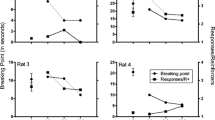Abstract
Food intake of four adult male baboons (Papio c. anubis) was monitored during daily experimental sessions lasting 22 h. Food was available under a two-component operant schedule. Following completion of the first “procurement component” response requirement, access to food, i.e., a meal, became available under the second “consumption component” during which each response produced a 1-g food pellet. After a 10-min interval in which no response occurred, the consumption component was terminated. The effects of diazepam (DZP: 0.12–4.0 mg/kg) were determined by having the baboons drink a dose on Tuesdays and Fridays 45–60 min before the daily session. DZP produced dose-dependent increases in food intake in three of the four baboons. DZP increased the size of the first two meals and total duration of eating, but had no effect on eating rate or the number of meals within a session. The effect of DZP on the topography of feeding of baboons differs from previous reports on the effects of benzodiazepines on the topography of feeding in rodents. This suggests that species or procedural differences influence the effects of DZP on food intake.
Similar content being viewed by others
References
Bainbridge JG (1968) The effect of psychotropic drugs on food reinforced behaviour and on food consumption. Psychopharmacologia 12:204–213.
Berridge KC, Treit D (1986) Chlordiazepoxide directly enhances positive ingestive reactions in rats. Pharmacol Biochem Behav 24:217–221.
Blundell JE (1977) Is there a role for serotonin (5-hydroxytryptamine) in feeding? Int J Obes 1:15–42.
Blundell JE, Latham CJ (1982) Behavioural pharmacology of feeding. In: Silverstone T (ed) Drugs and appetite. Academic Press, London, pp 41–80.
Brown DE, Fottler HJ, Pugh JL, Fahey GC Jr, Corbin JE (1981) Effects of elfazepam on feeding behavior, feed intake and nutrient utilization by the dog. Nutr Rep Int 24:785–789.
Brown RF, Houpt KA, Schryver HF (1976) Stimulation of food-intake in horses by diazepam and promazine. Pharmacol Biochem Behav 5:495–497.
Cooper SJ (1980) Benzodiazepines as appetite-enhancing compounds. Appetite 1:7–19.
Cooper SJ, Francis RL (1979) Feeding parameters with two food textures after chlordiazepoxide administration, alone or in combination with d-amphetamine or fenfluramine. Psychopharmacology 62:253–259.
Cooper SJ, Posadas-Andrews A (1979) Food and water intake in the non-deprived pigeon after chlordiazepoxide administration. Psychopharmacology 65:99–101.
Cooper SJ, Webb ZM (1984) Microstructural analysis of chlordiazepoxide's effects on food preference behavior in roman high-, control and low-avoidance rat. Physiol Behav 32:581–588.
Cooper SJ, Yerbury RE (1986) Midazolam-induceduhyperphagia and FG 7142-induced anorexia: behavioral characteristics in the rat. Pharmacol Biochem Behav 25:99–106.
Delgado JMR, Grau C, Delgado-Garcia JM, Rodero JM (1976) Effects of diazepam related to social hierarchy in rhesus monkeys. Neuropharmacology 15:409–414.
Feldman RS, Smith WC (1978) Chlordiazepoxide-fluoxetine interactions on food intake in free-feeding rats. Pharmacol Biochem Behav 8:749–752.
Foltin RW, Fischman MW (1988) The effects of varying procurement costs on food intake in baboons. Physiol Behav 43:493–499.
Foltin RW, Schuster CR (1983) Interaction between the effects of intragastric meals and drugs on feeding in rhesus monkeys. J Pharmacol Exp Ther 226:405–410.
Foltin RW, Ellis S, Schuster CR (1985) Specific antagonism by RO-15-1788 of benzodiazepine-induced increases in food intake in rhesus monkeys. Pharmacol Biochem Behav 23:249–252.
Fratta W, Mereu G, Chessa P, Paglietti E, Gessa G (1976) Benzodiazepine-induced voraciousness in rats and inhibition of amphetamine-anorexia. Life Sci 18:1157–1166.
Johnson DN (1978) Effect of diazepam on food consumption in rats. Psychopharmacology 56:111–112.
Leibowitz SF, Shor-Posner G (1986) Brain serotonin and eating behavior. Appetite [Suppl 7]:1–14
Leibowitz SF, Shor-Posner G, Maclow C, Grinker J (1986) Amphetamine: effects on meal patterns and macronutrient selection. Brain Res Bull 17:663–671.
Mereu GP, Fratta W, Chessa P, Gessa GL (1976) Voraciousness induced in cats by benzodiazepines. Psychopharmacology 47:101–103.
Poschel BPH (1971) A simple and specific screen for benzodiazepine-like drugs. Psychopharmacologia 19:193–198.
Soubrie P, DeAngelis L, Simon P, Boisser JR (1976) Effects des anxiolytiques sur la prise de boisson en situation nouvelle et familiere. Psychopharmacologia 50:41–45.
Author information
Authors and Affiliations
Rights and permissions
About this article
Cite this article
Foltin, R.W., Fischman, M.W. & Byrne, M.F. Food intake in baboons: effects of diazepam. Psychopharmacology 97, 443–447 (1989). https://doi.org/10.1007/BF00439545
Received:
Accepted:
Issue Date:
DOI: https://doi.org/10.1007/BF00439545




